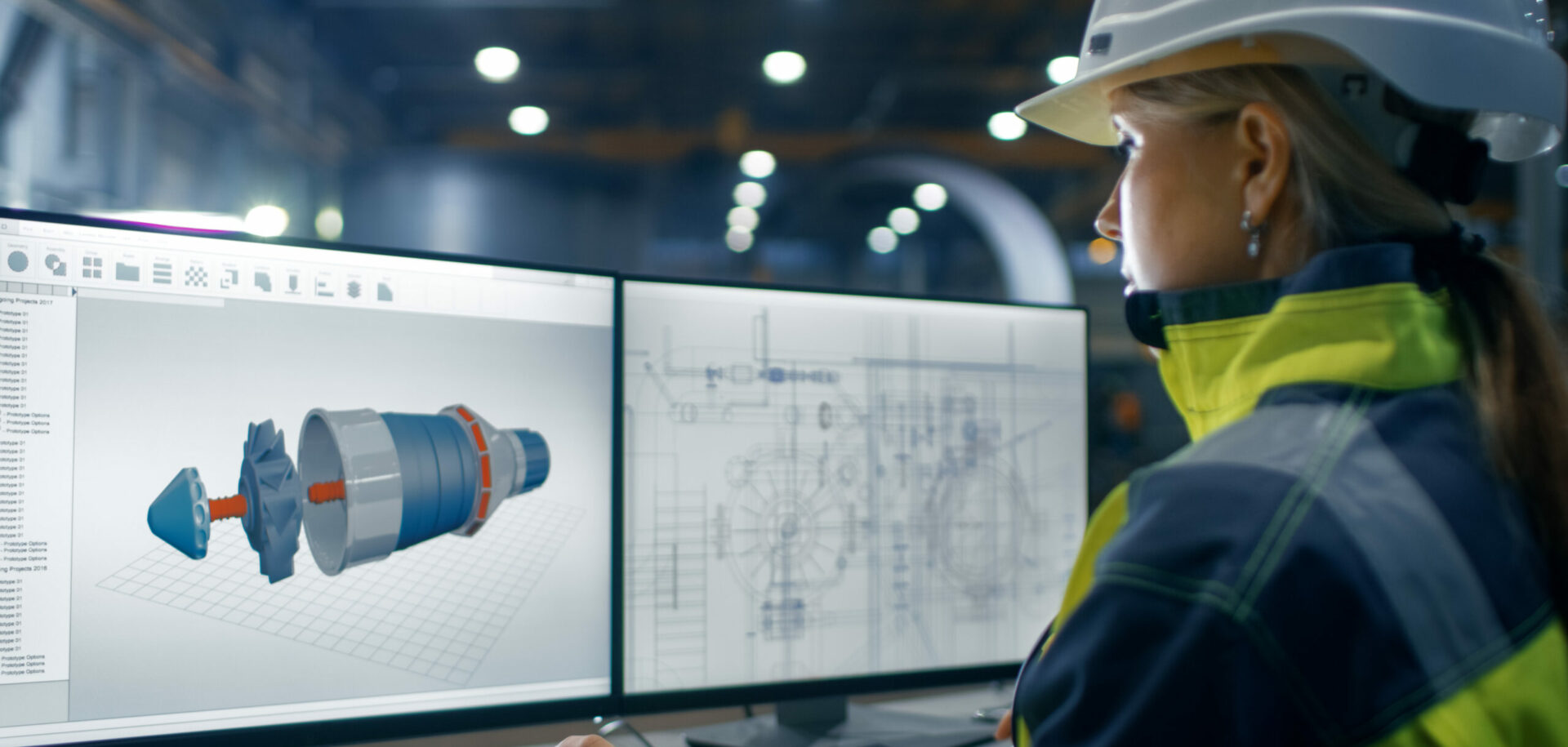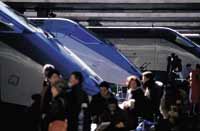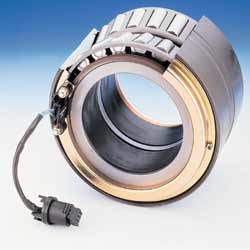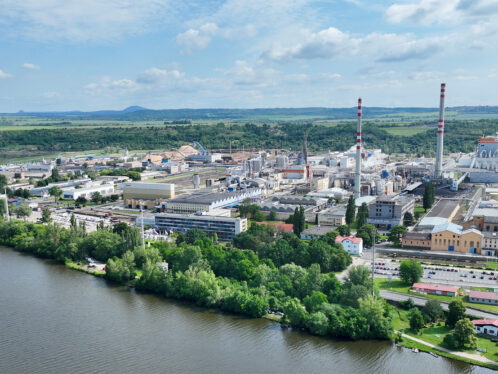
Summary
Essential components
The journal bearing is arguably the single most important component in the manufacture of trains. The demands on SKF are almost as arduous as the demands on the bearing itself: years of service, maximum reliability, perfect performance.
To satisfy FS requirements, the SKF TBUs (tapered roller bearing units) are sealed and lubricated for life in ready-to-fit units. The desired wheel life is achieved without any intermediate maintenance of the TBU.
In recent years, SKF’s sensorised bearings have also redefined the parameters of railway safety. The TBU axlebox incorporates sensors that detect bearing temperature and speed on the Pendolino and high-speed trains.
The temperature is detected in the loaded zone of the bearing and acts as an excellent indicator of the bearing performance at high speed – a critical factor in modern safety requirements.
Rather like the antilock brake system used on motor vehicles, the speed sensor is linked to the train’s electronic brake unit and stops wheel sliding and locking during emergency stops. A high-speed train takes several kilometres to come to a halt from full speed.
The stationary labyrinth seal mounted onto the outer ring carries the sensor unit housed in a lightweight metal casing. The rotating part of the metal seal is used as a support ring for the magnetic impulse wheel.
SKF sensors will also be used for automatic train control equipment. They are approved by the Union Internationale des Chemins de Fer (UIC).
A long lasting partnership
The partnership of Ferrovie dello Stato SpA (FS) with SKF stretches back to 1923. The two companies cooperate on a variety of bearings for axleboxes and other applications such as traction motors and gearboxes. “No other supplier has taken the time to develop this kind of relationship with us,” says Domenico Maresca, No. 3 in the FS hierarchy. In the past 10 years, the partnership has yielded a vast improvement in the bearing service life. The older roller bearings used on intercity coaches required overhauling after 350,000 kilometres. With the introduction of the TBU (tapered roller bearing unit), bearings will roll for 1 million kilometres without maintenance. SKF remains the only company currently manufacturing the state-of-the-art sensorised bearing units used in Pendolino high-speed trains.
It’s no accident that Italy came together as a nation around the same time that railways first linked the extremities of Europe’s longest peninsula. The spread of the railways helped to forge a national consciousness.When the Rome-Palermo Express reaches the Straits of Messina, which divide mainland Italy from Sicily, first-time travellers are often surprised to find there’s no bridge.
Carriages and cargo are rolled one by one onto a ferry, which pilots a course between Scylla and Charybdis, the twin hazards of rock and whirlpool that guard Messina. Twenty minutes later, the Express resumes its journey to Palermo. It is just one example of the engineering ingenuity required to unite Italy’s national rail network.
It took more than 100 years and 16,000 kilometres of railway line for the Ferrovie dello Stato SpA (FS), Italy’s state railway, to link the extremities of Europe’s longest peninsula, from mountain villages in the Dolomites and Apennines to remote towns in the very heel of the Italian boot.
Such is the geographical spread of Italy’s railways that in the mid-19th century they helped forge a national consciousness: The Florence-Pisa, Turin-Genoa, Turin-Moncalieri and Milan-Venice lines were all completed in the 1840s.
“In Italy, the railway network was never just a means to move from city to city, but also a symbol of Italian unity,” says Enrico Passalacqua, a member of the FS technical office in Florence.
Unlike many northern European countries, where railways often can follow the straightest route between two stations, Italy is split in half by mountains. Italy’s tracks criss-cross through the Apennines, cutting through ravines and tunnels and winding across viaducts.
Yet FS’s fleet of high-speed Pendolino trains made by Fiat Ferroviaria – the ETR 450/460/480/470 and HST- ETR500 – today exceed speeds of 250 kilometres per hour on tracks that were designed for half that speed. The trick lies in the motion of the Pendolino – Italian for pendulum. “On bends, the train tilts eight degrees towards the centre of its path, compensating for centrifugal acceleration,” says Domenico Maresca, technical manager and number three in the FS hierarchy.
As a result, the train can take Italy’s winding tracks at speeds 35 percent higher than traditional intercity trains, without affecting the traveller’s comfort. The slant of each carriage is managed by a control system based on a microprocessor that sends information to the hydraulic actuators.
“We wanted to reduce the time between one station and another without changing the infrastructure,” says Maresca. “The Pendolino was the answer.”
Where the old lines have been replaced with special high-speed track between Florence and Rome, the ETR 500 exceeds 300 kilometres per hour.
The technological know-how behind the Pendolino is apparent at the engine house near Rome’s main Termini station. The enormous hangar-like structure holds eight trains, each raised on specially built track that allows engineers to strip and check the Pendolino’s hi-tech components.
Today, FS’s ETR fleet numbers 60, but the Pendolino’s success takes it far beyond the Italian capital. It runs twice a day between Italy and France as well as connecting Florence to Zurich, Milan to Geneva and Munich to Stuttgart. In Britain, Virgin has also adopted the pendular solution to high-speed travel on winding tracks. “The future idea is to give the FS’s Pendolino the chance to connect more and more passengers to more and more foreign destinations,” says Maresca.
If the development of an intercity and international high-speed train dominated the work of FS technicians in the 1990s, the beginning of the new millennium is once again testing the company’s historic inventiveness.
Back to the future
As part of the long-term rationalisation of FS, financial responsibility for Italy’s local network was transferred on January 1 to the nation’s 49 regional governments, a decision that takes the national railway system back to the future.
Italy’s first train companies were run by the city-states that ruled the peninsula for the first half of the 19th century. On October 3, 1839, the Kingdom of the Two Sicilies built the nation’s first railway to connect the royal residences of Naples and Portici. The rulers of the other states, not wishing to be outdone, quickly followed suit, with rulers laying their own lines in the Lombardy-Venetian State, the Grand Duchy of Tuscany, Piedmont and the Papal States.
While the early railways were reserved for royal families, the priority now is a cost-efficient service that encourages Italian commuters to take advantage of one of Europe’s most extensive networks.
“Whenever the builders of Italy’s railways ran into a mountain, they faced a dilemma: Should they go right or left?” says Marco Esposito, railway correspondent for Rome daily La Repubblica. “To keep everyone happy, they invariably went both ways. The result is a network that passes through even the smallest village.” However, until now, the FS technical department has struggled to break the strong ties between the average Italian and his or her beloved car. For much of the 1990s, luxurious train travel was limited to the intercity traveller, while the local commuter had to make do with old rolling stock.
Now FS engineers in Florence have come up with a train that matches the Pendolino for comfort: the high-frequency train (TAF).
Built like a double-decker bus, with plush seats and air-conditioning, the TAF is designed to serve the hinterland of Italy’s regional capitals and is specially designed for local traffic.
The first 24 TAFs have already been delivered, with a further 250 on order, including 30 for the Veneto and Lombardy regions. The train is already operating on the lines connecting Rome’s Fiumicino airport and Malpensa airport to Milan.
“The regions will become our most important customers over the next few years,” says Maresca. “Most have money and want to spend it.”
Chris Endean
Rome correspondent for the Sunday Telegraph
photos Antonello Nusca






